Queensford College: FNSACC607 Evaluate Business Performance Project
VerifiedAdded on 2023/01/04
|24
|4298
|47
Project
AI Summary
This assignment evaluates business performance through a case study and written activities. It begins with the calculation and interpretation of various financial ratios, including gross profit, net profit, liquid, accounts receivable, inventory turnover, return on equity, debt to equity, total asset turnover, return on investment, economic value added, and residual income. The analysis extends to budgeting, short-term and long-term objectives, and performance indicators for SLD Corporation, including strategies for employee engagement, customer satisfaction, and the implementation of a balanced scorecard. The project explores benchmarking, factors influencing performance measurement systems, employee rewards, communication strategies, and capital investment decisions. Additionally, the assignment includes a ratio analysis of C Juice, a SWOT analysis, and a course of action, providing a comprehensive overview of business performance evaluation.
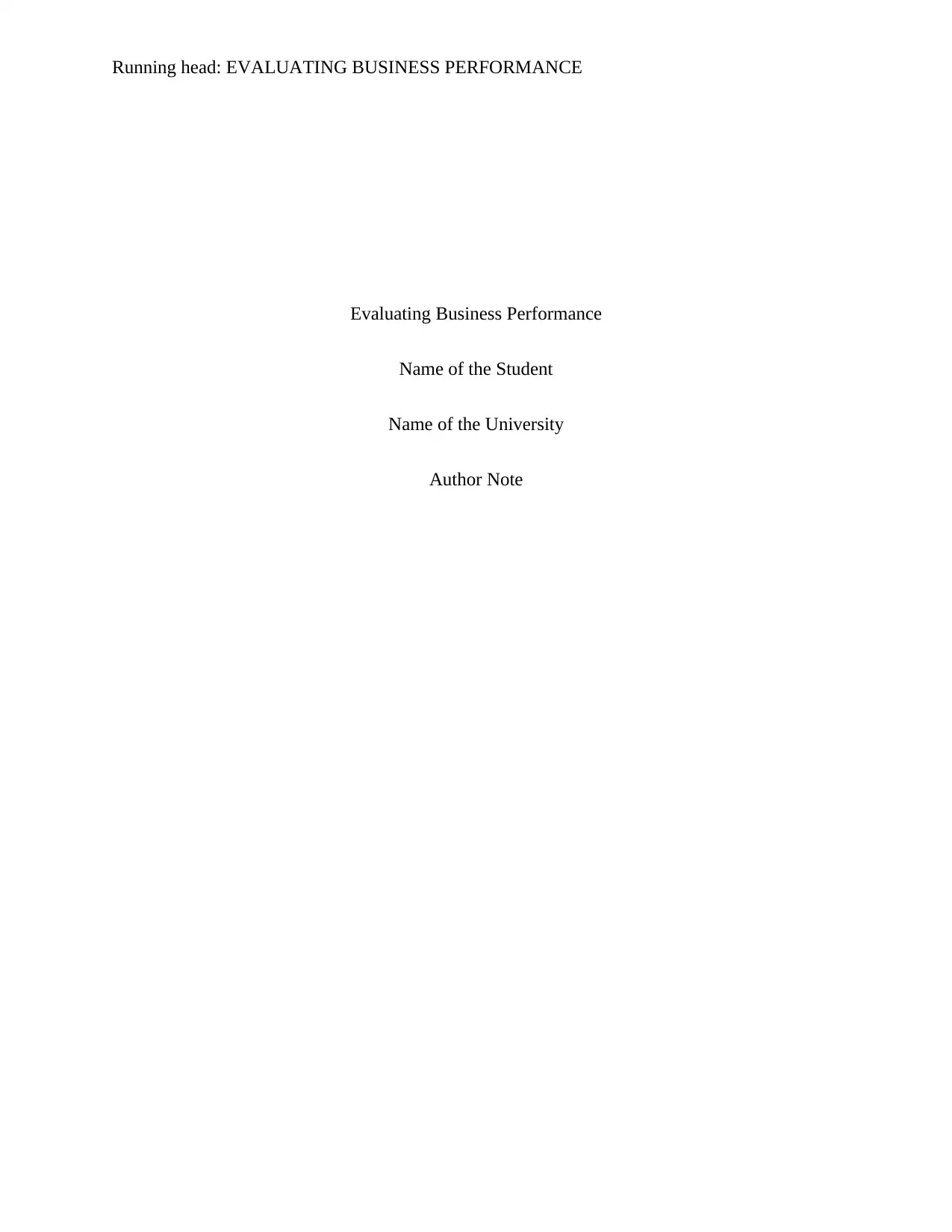
Running head: EVALUATING BUSINESS PERFORMANCE
Evaluating Business Performance
Name of the Student
Name of the University
Author Note
Evaluating Business Performance
Name of the Student
Name of the University
Author Note
Paraphrase This Document
Need a fresh take? Get an instant paraphrase of this document with our AI Paraphraser
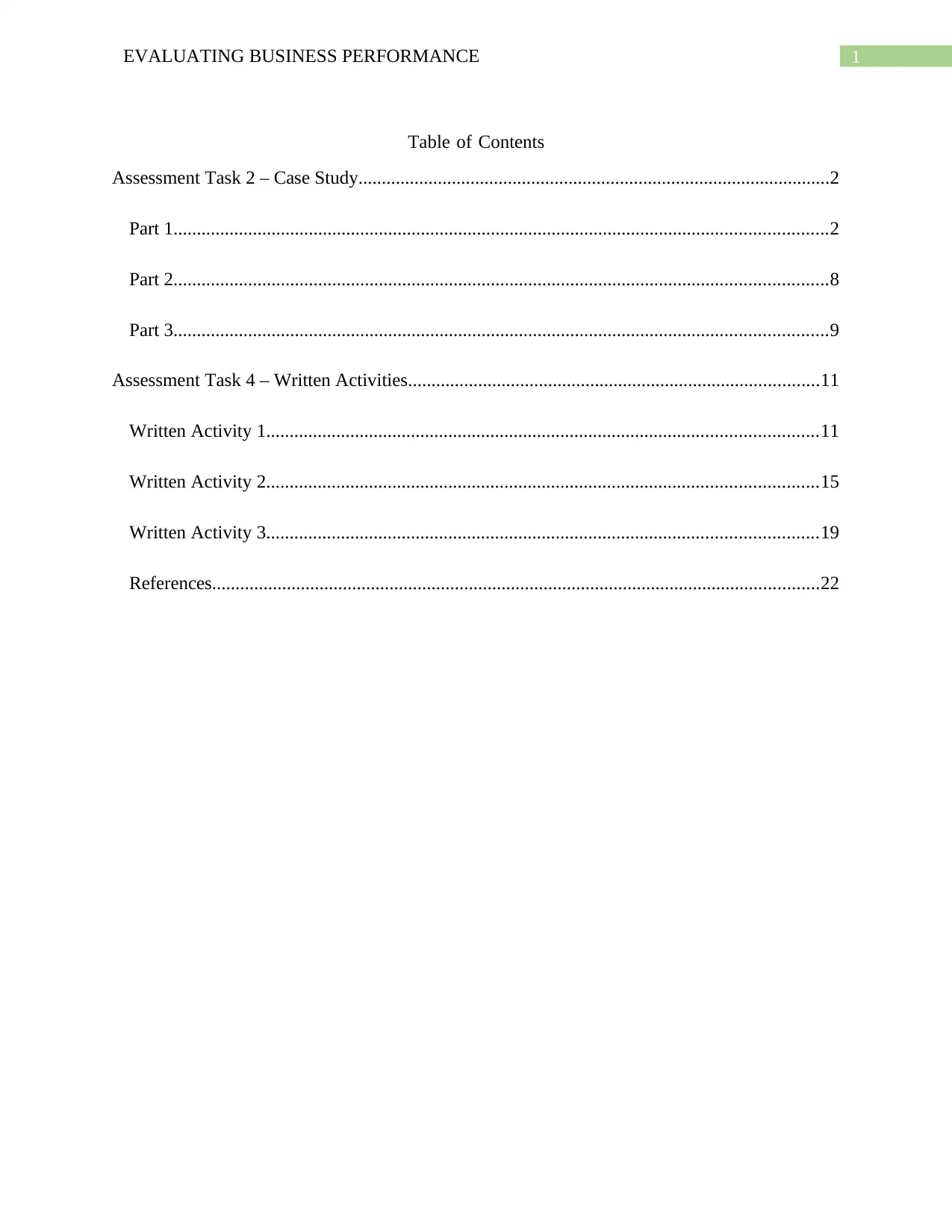
1EVALUATING BUSINESS PERFORMANCE
Table of Contents
Assessment Task 2 – Case Study.....................................................................................................2
Part 1............................................................................................................................................2
Part 2............................................................................................................................................8
Part 3............................................................................................................................................9
Assessment Task 4 – Written Activities........................................................................................11
Written Activity 1......................................................................................................................11
Written Activity 2......................................................................................................................15
Written Activity 3......................................................................................................................19
References..................................................................................................................................22
Table of Contents
Assessment Task 2 – Case Study.....................................................................................................2
Part 1............................................................................................................................................2
Part 2............................................................................................................................................8
Part 3............................................................................................................................................9
Assessment Task 4 – Written Activities........................................................................................11
Written Activity 1......................................................................................................................11
Written Activity 2......................................................................................................................15
Written Activity 3......................................................................................................................19
References..................................................................................................................................22
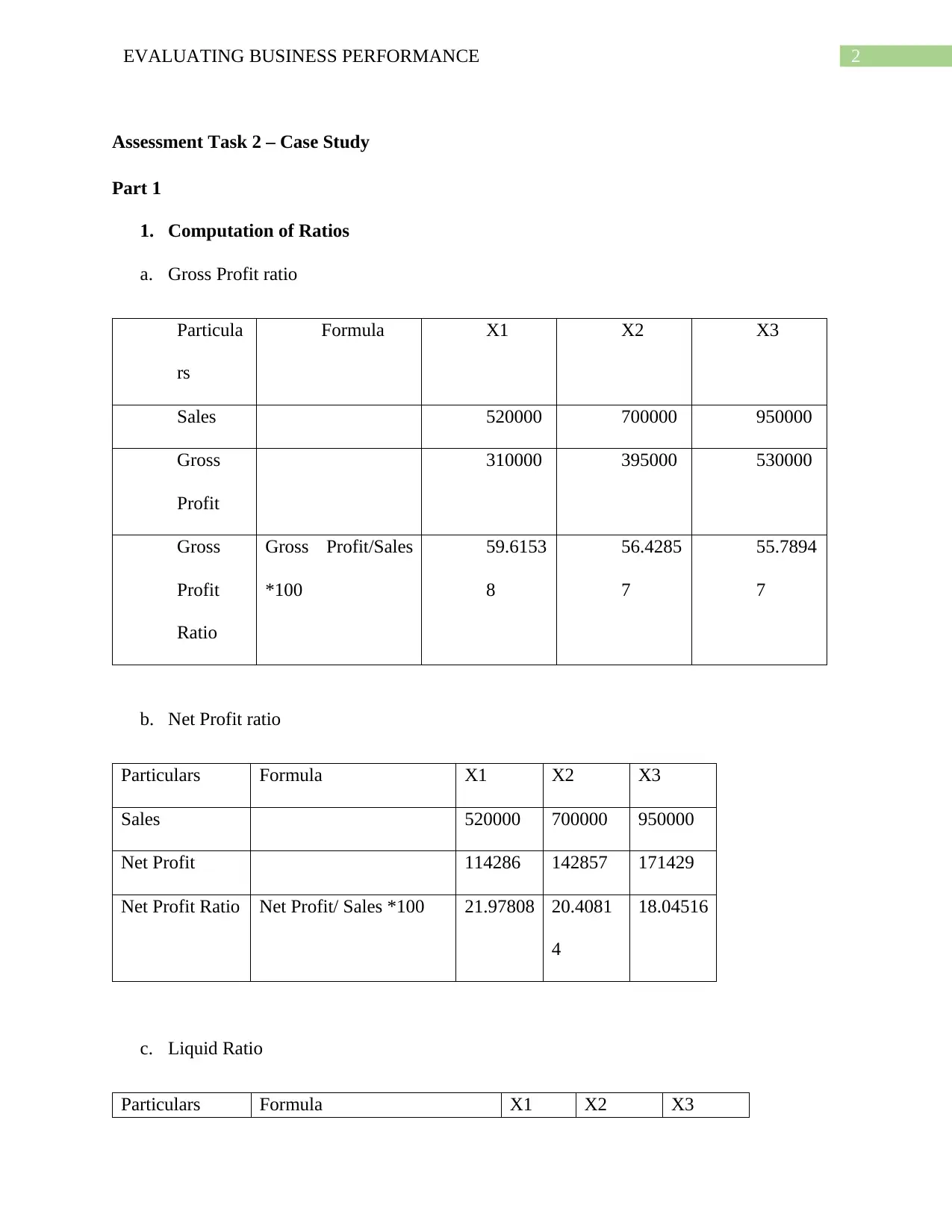
2EVALUATING BUSINESS PERFORMANCE
Assessment Task 2 – Case Study
Part 1
1. Computation of Ratios
a. Gross Profit ratio
Particula
rs
Formula X1 X2 X3
Sales 520000 700000 950000
Gross
Profit
310000 395000 530000
Gross
Profit
Ratio
Gross Profit/Sales
*100
59.6153
8
56.4285
7
55.7894
7
b. Net Profit ratio
Particulars Formula X1 X2 X3
Sales 520000 700000 950000
Net Profit 114286 142857 171429
Net Profit Ratio Net Profit/ Sales *100 21.97808 20.4081
4
18.04516
c. Liquid Ratio
Particulars Formula X1 X2 X3
Assessment Task 2 – Case Study
Part 1
1. Computation of Ratios
a. Gross Profit ratio
Particula
rs
Formula X1 X2 X3
Sales 520000 700000 950000
Gross
Profit
310000 395000 530000
Gross
Profit
Ratio
Gross Profit/Sales
*100
59.6153
8
56.4285
7
55.7894
7
b. Net Profit ratio
Particulars Formula X1 X2 X3
Sales 520000 700000 950000
Net Profit 114286 142857 171429
Net Profit Ratio Net Profit/ Sales *100 21.97808 20.4081
4
18.04516
c. Liquid Ratio
Particulars Formula X1 X2 X3
⊘ This is a preview!⊘
Do you want full access?
Subscribe today to unlock all pages.

Trusted by 1+ million students worldwide
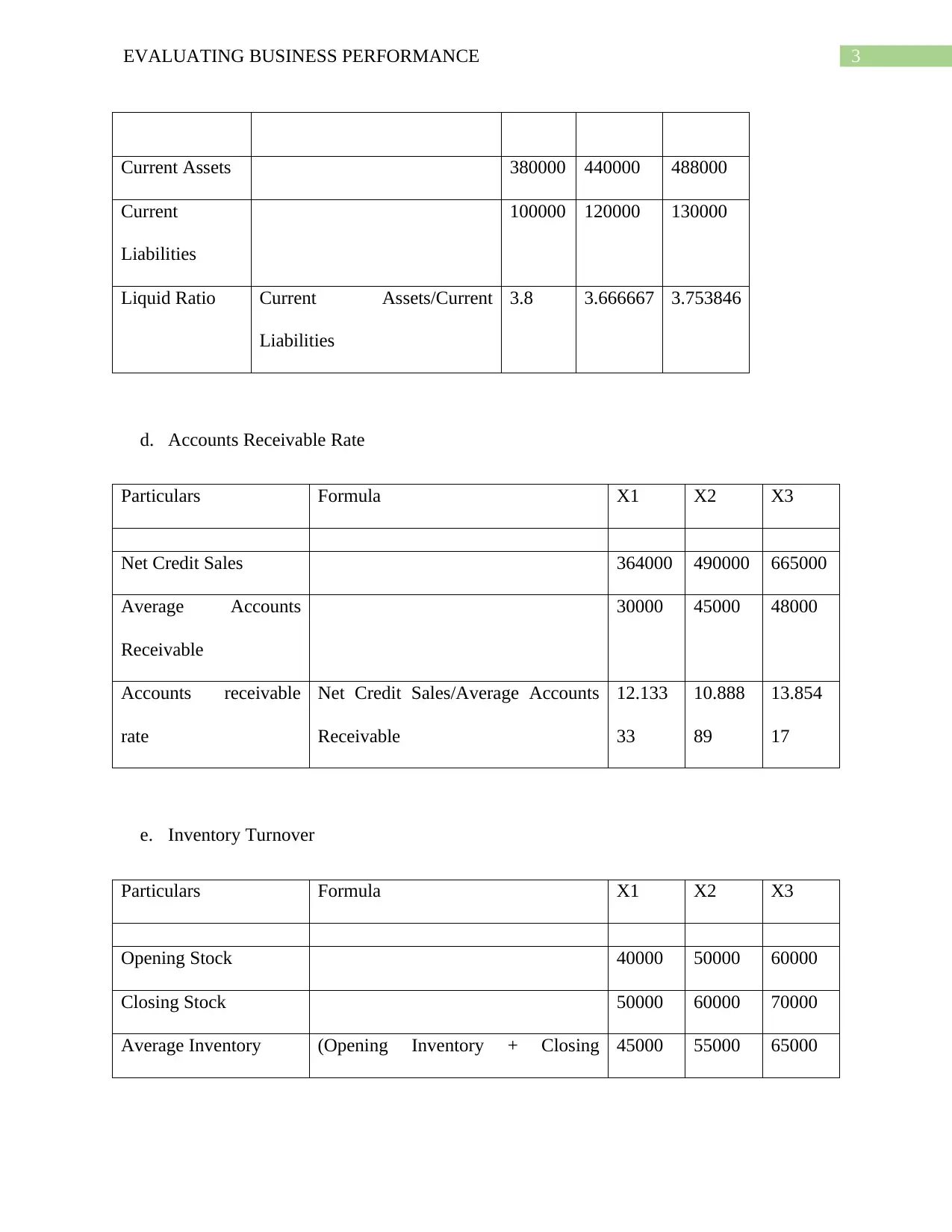
3EVALUATING BUSINESS PERFORMANCE
Current Assets 380000 440000 488000
Current
Liabilities
100000 120000 130000
Liquid Ratio Current Assets/Current
Liabilities
3.8 3.666667 3.753846
d. Accounts Receivable Rate
Particulars Formula X1 X2 X3
Net Credit Sales 364000 490000 665000
Average Accounts
Receivable
30000 45000 48000
Accounts receivable
rate
Net Credit Sales/Average Accounts
Receivable
12.133
33
10.888
89
13.854
17
e. Inventory Turnover
Particulars Formula X1 X2 X3
Opening Stock 40000 50000 60000
Closing Stock 50000 60000 70000
Average Inventory (Opening Inventory + Closing 45000 55000 65000
Current Assets 380000 440000 488000
Current
Liabilities
100000 120000 130000
Liquid Ratio Current Assets/Current
Liabilities
3.8 3.666667 3.753846
d. Accounts Receivable Rate
Particulars Formula X1 X2 X3
Net Credit Sales 364000 490000 665000
Average Accounts
Receivable
30000 45000 48000
Accounts receivable
rate
Net Credit Sales/Average Accounts
Receivable
12.133
33
10.888
89
13.854
17
e. Inventory Turnover
Particulars Formula X1 X2 X3
Opening Stock 40000 50000 60000
Closing Stock 50000 60000 70000
Average Inventory (Opening Inventory + Closing 45000 55000 65000
Paraphrase This Document
Need a fresh take? Get an instant paraphrase of this document with our AI Paraphraser
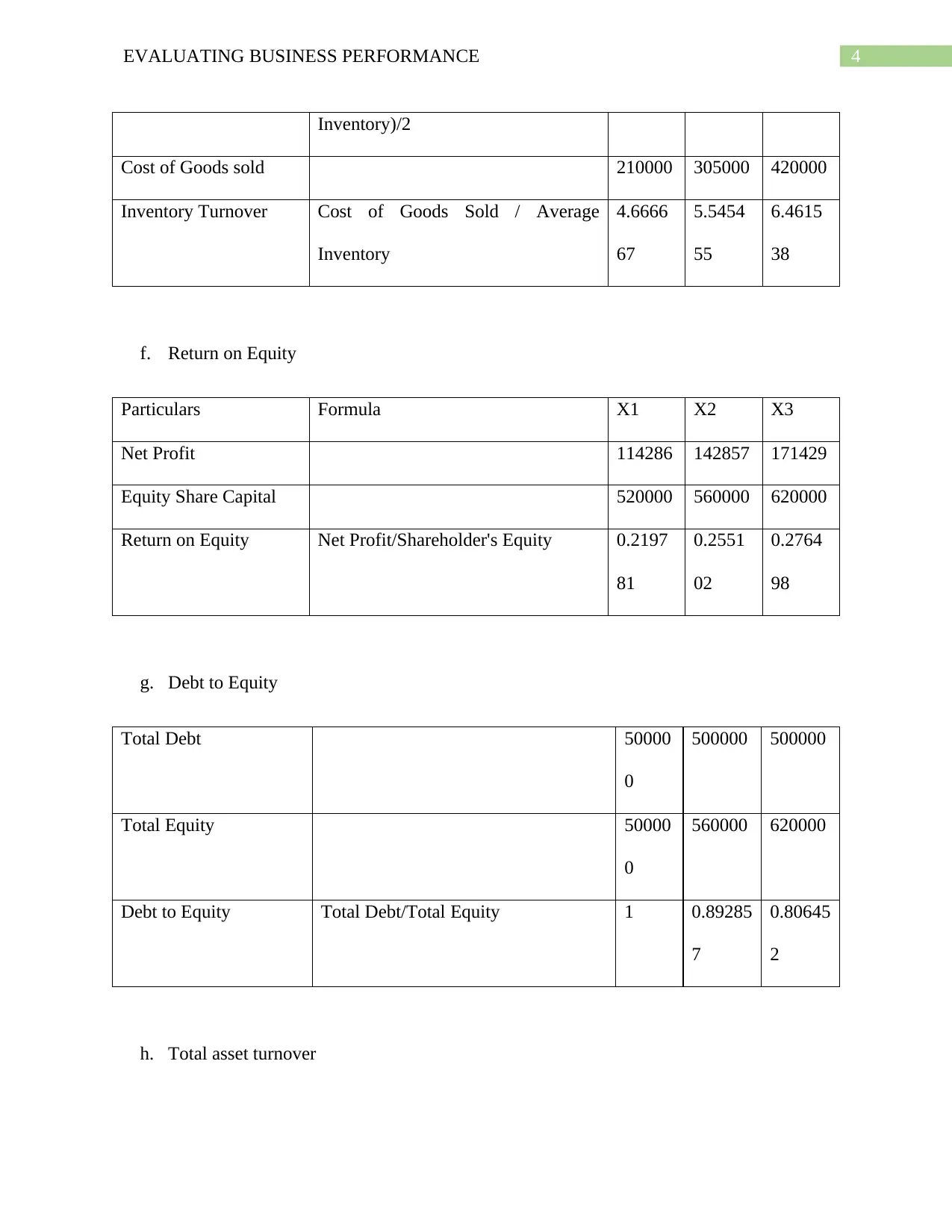
4EVALUATING BUSINESS PERFORMANCE
Inventory)/2
Cost of Goods sold 210000 305000 420000
Inventory Turnover Cost of Goods Sold / Average
Inventory
4.6666
67
5.5454
55
6.4615
38
f. Return on Equity
Particulars Formula X1 X2 X3
Net Profit 114286 142857 171429
Equity Share Capital 520000 560000 620000
Return on Equity Net Profit/Shareholder's Equity 0.2197
81
0.2551
02
0.2764
98
g. Debt to Equity
Total Debt 50000
0
500000 500000
Total Equity 50000
0
560000 620000
Debt to Equity Total Debt/Total Equity 1 0.89285
7
0.80645
2
h. Total asset turnover
Inventory)/2
Cost of Goods sold 210000 305000 420000
Inventory Turnover Cost of Goods Sold / Average
Inventory
4.6666
67
5.5454
55
6.4615
38
f. Return on Equity
Particulars Formula X1 X2 X3
Net Profit 114286 142857 171429
Equity Share Capital 520000 560000 620000
Return on Equity Net Profit/Shareholder's Equity 0.2197
81
0.2551
02
0.2764
98
g. Debt to Equity
Total Debt 50000
0
500000 500000
Total Equity 50000
0
560000 620000
Debt to Equity Total Debt/Total Equity 1 0.89285
7
0.80645
2
h. Total asset turnover
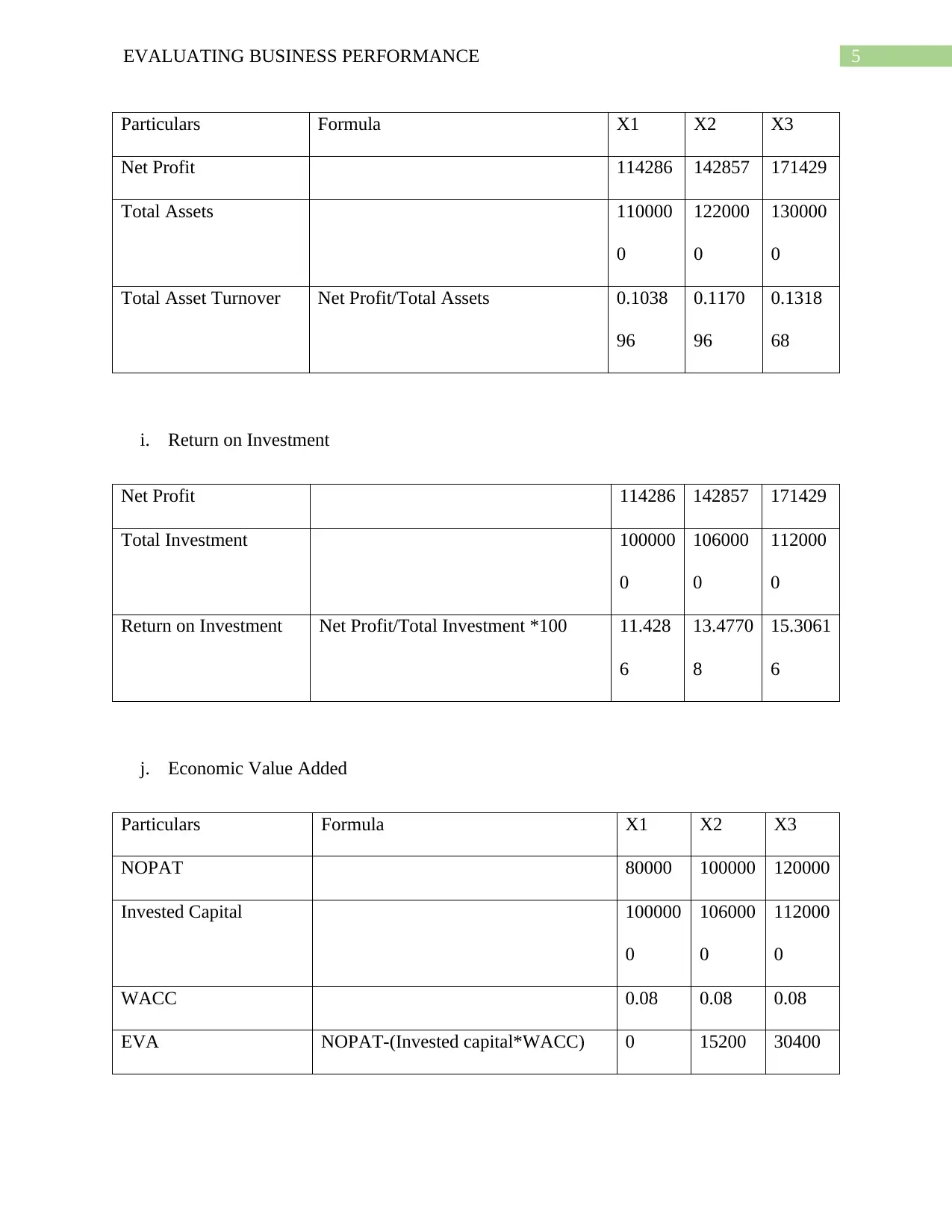
5EVALUATING BUSINESS PERFORMANCE
Particulars Formula X1 X2 X3
Net Profit 114286 142857 171429
Total Assets 110000
0
122000
0
130000
0
Total Asset Turnover Net Profit/Total Assets 0.1038
96
0.1170
96
0.1318
68
i. Return on Investment
Net Profit 114286 142857 171429
Total Investment 100000
0
106000
0
112000
0
Return on Investment Net Profit/Total Investment *100 11.428
6
13.4770
8
15.3061
6
j. Economic Value Added
Particulars Formula X1 X2 X3
NOPAT 80000 100000 120000
Invested Capital 100000
0
106000
0
112000
0
WACC 0.08 0.08 0.08
EVA NOPAT-(Invested capital*WACC) 0 15200 30400
Particulars Formula X1 X2 X3
Net Profit 114286 142857 171429
Total Assets 110000
0
122000
0
130000
0
Total Asset Turnover Net Profit/Total Assets 0.1038
96
0.1170
96
0.1318
68
i. Return on Investment
Net Profit 114286 142857 171429
Total Investment 100000
0
106000
0
112000
0
Return on Investment Net Profit/Total Investment *100 11.428
6
13.4770
8
15.3061
6
j. Economic Value Added
Particulars Formula X1 X2 X3
NOPAT 80000 100000 120000
Invested Capital 100000
0
106000
0
112000
0
WACC 0.08 0.08 0.08
EVA NOPAT-(Invested capital*WACC) 0 15200 30400
⊘ This is a preview!⊘
Do you want full access?
Subscribe today to unlock all pages.

Trusted by 1+ million students worldwide
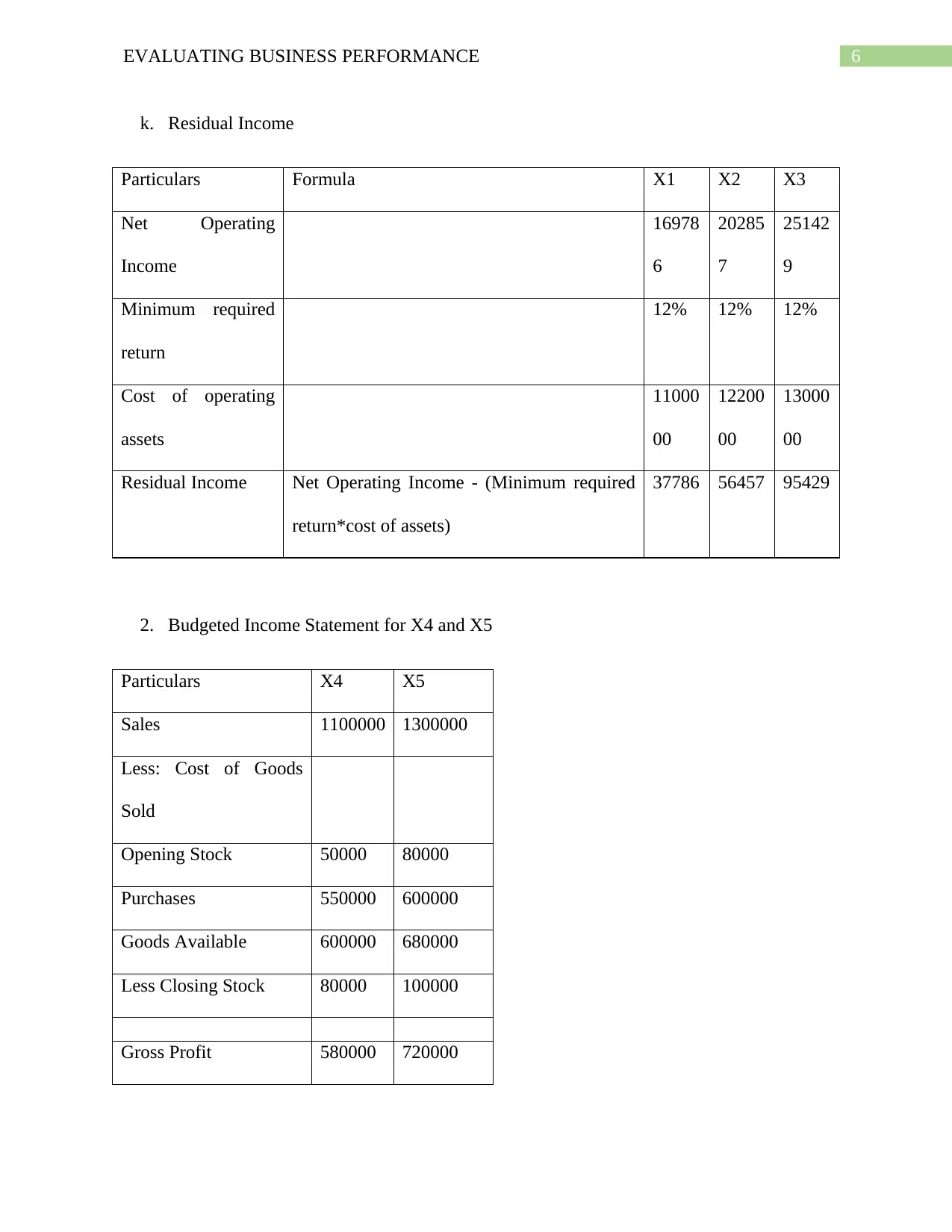
6EVALUATING BUSINESS PERFORMANCE
k. Residual Income
Particulars Formula X1 X2 X3
Net Operating
Income
16978
6
20285
7
25142
9
Minimum required
return
12% 12% 12%
Cost of operating
assets
11000
00
12200
00
13000
00
Residual Income Net Operating Income - (Minimum required
return*cost of assets)
37786 56457 95429
2. Budgeted Income Statement for X4 and X5
Particulars X4 X5
Sales 1100000 1300000
Less: Cost of Goods
Sold
Opening Stock 50000 80000
Purchases 550000 600000
Goods Available 600000 680000
Less Closing Stock 80000 100000
Gross Profit 580000 720000
k. Residual Income
Particulars Formula X1 X2 X3
Net Operating
Income
16978
6
20285
7
25142
9
Minimum required
return
12% 12% 12%
Cost of operating
assets
11000
00
12200
00
13000
00
Residual Income Net Operating Income - (Minimum required
return*cost of assets)
37786 56457 95429
2. Budgeted Income Statement for X4 and X5
Particulars X4 X5
Sales 1100000 1300000
Less: Cost of Goods
Sold
Opening Stock 50000 80000
Purchases 550000 600000
Goods Available 600000 680000
Less Closing Stock 80000 100000
Gross Profit 580000 720000
Paraphrase This Document
Need a fresh take? Get an instant paraphrase of this document with our AI Paraphraser
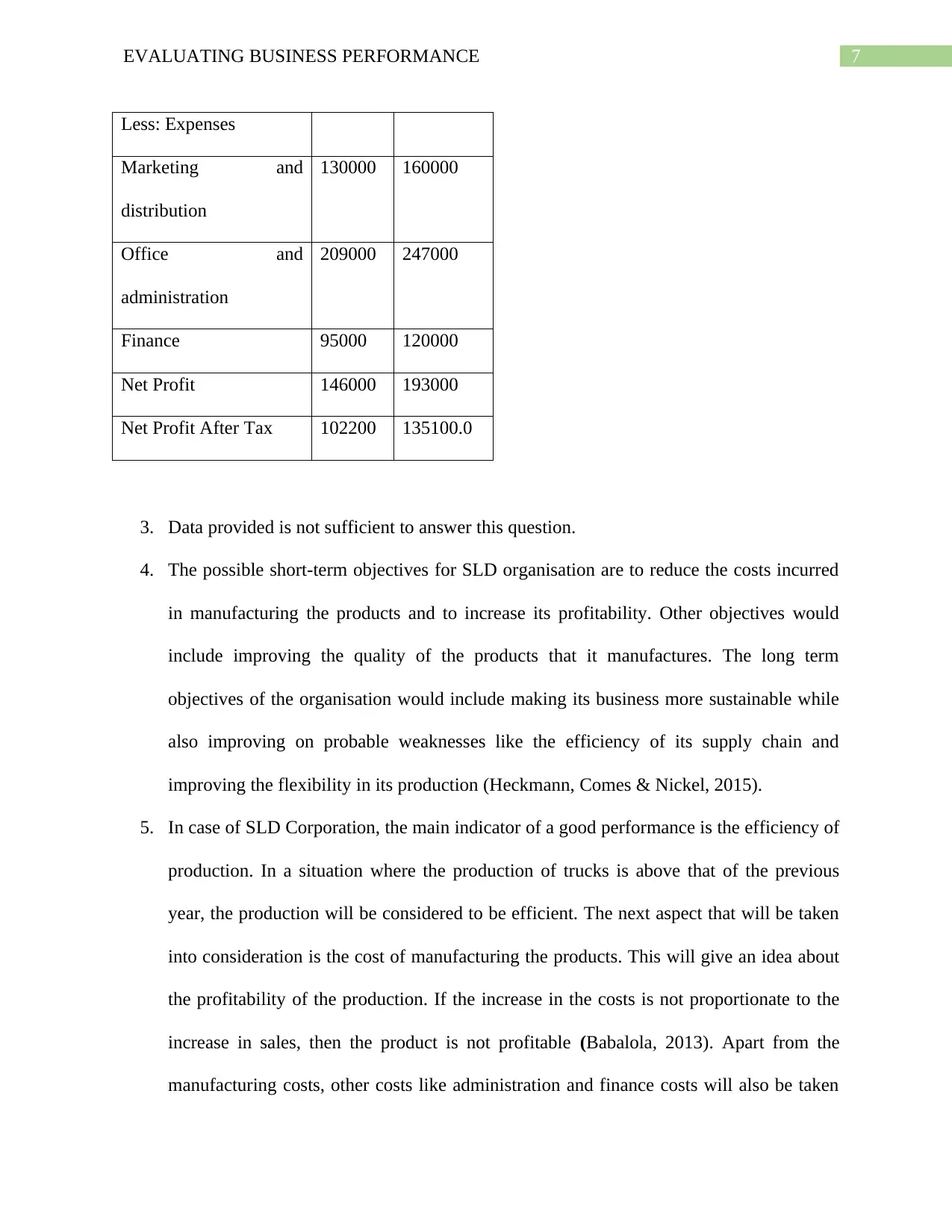
7EVALUATING BUSINESS PERFORMANCE
Less: Expenses
Marketing and
distribution
130000 160000
Office and
administration
209000 247000
Finance 95000 120000
Net Profit 146000 193000
Net Profit After Tax 102200 135100.0
3. Data provided is not sufficient to answer this question.
4. The possible short-term objectives for SLD organisation are to reduce the costs incurred
in manufacturing the products and to increase its profitability. Other objectives would
include improving the quality of the products that it manufactures. The long term
objectives of the organisation would include making its business more sustainable while
also improving on probable weaknesses like the efficiency of its supply chain and
improving the flexibility in its production (Heckmann, Comes & Nickel, 2015).
5. In case of SLD Corporation, the main indicator of a good performance is the efficiency of
production. In a situation where the production of trucks is above that of the previous
year, the production will be considered to be efficient. The next aspect that will be taken
into consideration is the cost of manufacturing the products. This will give an idea about
the profitability of the production. If the increase in the costs is not proportionate to the
increase in sales, then the product is not profitable (Babalola, 2013). Apart from the
manufacturing costs, other costs like administration and finance costs will also be taken
Less: Expenses
Marketing and
distribution
130000 160000
Office and
administration
209000 247000
Finance 95000 120000
Net Profit 146000 193000
Net Profit After Tax 102200 135100.0
3. Data provided is not sufficient to answer this question.
4. The possible short-term objectives for SLD organisation are to reduce the costs incurred
in manufacturing the products and to increase its profitability. Other objectives would
include improving the quality of the products that it manufactures. The long term
objectives of the organisation would include making its business more sustainable while
also improving on probable weaknesses like the efficiency of its supply chain and
improving the flexibility in its production (Heckmann, Comes & Nickel, 2015).
5. In case of SLD Corporation, the main indicator of a good performance is the efficiency of
production. In a situation where the production of trucks is above that of the previous
year, the production will be considered to be efficient. The next aspect that will be taken
into consideration is the cost of manufacturing the products. This will give an idea about
the profitability of the production. If the increase in the costs is not proportionate to the
increase in sales, then the product is not profitable (Babalola, 2013). Apart from the
manufacturing costs, other costs like administration and finance costs will also be taken
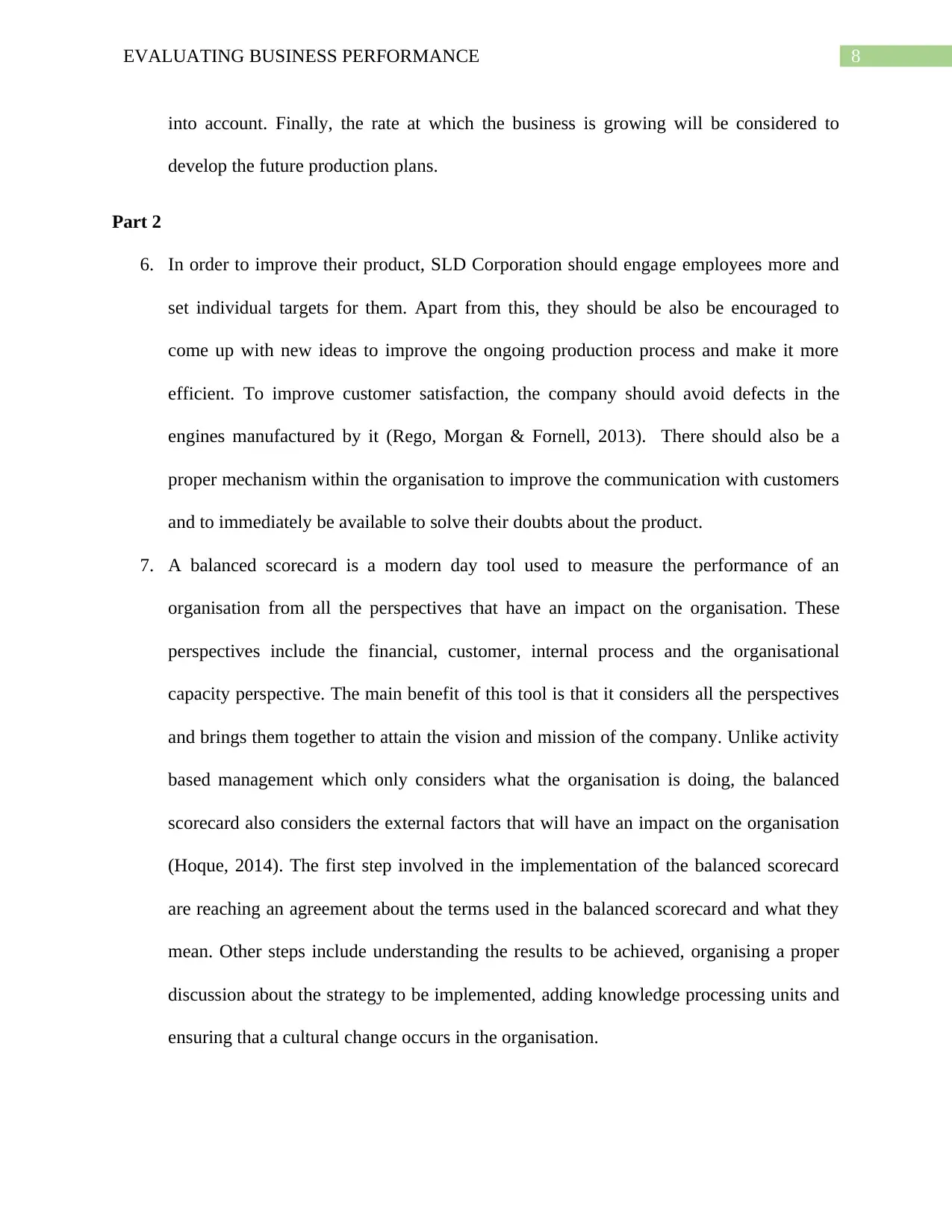
8EVALUATING BUSINESS PERFORMANCE
into account. Finally, the rate at which the business is growing will be considered to
develop the future production plans.
Part 2
6. In order to improve their product, SLD Corporation should engage employees more and
set individual targets for them. Apart from this, they should be also be encouraged to
come up with new ideas to improve the ongoing production process and make it more
efficient. To improve customer satisfaction, the company should avoid defects in the
engines manufactured by it (Rego, Morgan & Fornell, 2013). There should also be a
proper mechanism within the organisation to improve the communication with customers
and to immediately be available to solve their doubts about the product.
7. A balanced scorecard is a modern day tool used to measure the performance of an
organisation from all the perspectives that have an impact on the organisation. These
perspectives include the financial, customer, internal process and the organisational
capacity perspective. The main benefit of this tool is that it considers all the perspectives
and brings them together to attain the vision and mission of the company. Unlike activity
based management which only considers what the organisation is doing, the balanced
scorecard also considers the external factors that will have an impact on the organisation
(Hoque, 2014). The first step involved in the implementation of the balanced scorecard
are reaching an agreement about the terms used in the balanced scorecard and what they
mean. Other steps include understanding the results to be achieved, organising a proper
discussion about the strategy to be implemented, adding knowledge processing units and
ensuring that a cultural change occurs in the organisation.
into account. Finally, the rate at which the business is growing will be considered to
develop the future production plans.
Part 2
6. In order to improve their product, SLD Corporation should engage employees more and
set individual targets for them. Apart from this, they should be also be encouraged to
come up with new ideas to improve the ongoing production process and make it more
efficient. To improve customer satisfaction, the company should avoid defects in the
engines manufactured by it (Rego, Morgan & Fornell, 2013). There should also be a
proper mechanism within the organisation to improve the communication with customers
and to immediately be available to solve their doubts about the product.
7. A balanced scorecard is a modern day tool used to measure the performance of an
organisation from all the perspectives that have an impact on the organisation. These
perspectives include the financial, customer, internal process and the organisational
capacity perspective. The main benefit of this tool is that it considers all the perspectives
and brings them together to attain the vision and mission of the company. Unlike activity
based management which only considers what the organisation is doing, the balanced
scorecard also considers the external factors that will have an impact on the organisation
(Hoque, 2014). The first step involved in the implementation of the balanced scorecard
are reaching an agreement about the terms used in the balanced scorecard and what they
mean. Other steps include understanding the results to be achieved, organising a proper
discussion about the strategy to be implemented, adding knowledge processing units and
ensuring that a cultural change occurs in the organisation.
⊘ This is a preview!⊘
Do you want full access?
Subscribe today to unlock all pages.

Trusted by 1+ million students worldwide
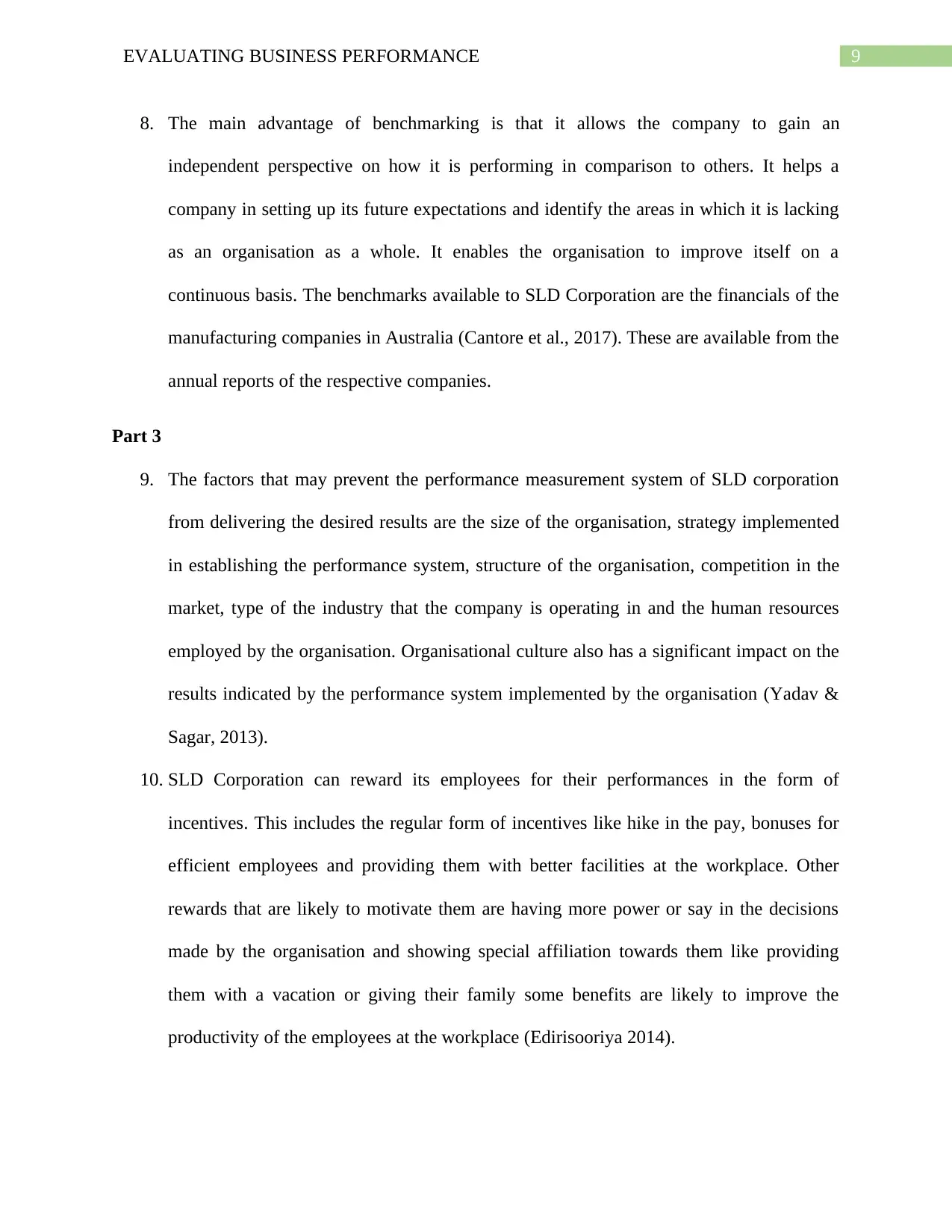
9EVALUATING BUSINESS PERFORMANCE
8. The main advantage of benchmarking is that it allows the company to gain an
independent perspective on how it is performing in comparison to others. It helps a
company in setting up its future expectations and identify the areas in which it is lacking
as an organisation as a whole. It enables the organisation to improve itself on a
continuous basis. The benchmarks available to SLD Corporation are the financials of the
manufacturing companies in Australia (Cantore et al., 2017). These are available from the
annual reports of the respective companies.
Part 3
9. The factors that may prevent the performance measurement system of SLD corporation
from delivering the desired results are the size of the organisation, strategy implemented
in establishing the performance system, structure of the organisation, competition in the
market, type of the industry that the company is operating in and the human resources
employed by the organisation. Organisational culture also has a significant impact on the
results indicated by the performance system implemented by the organisation (Yadav &
Sagar, 2013).
10. SLD Corporation can reward its employees for their performances in the form of
incentives. This includes the regular form of incentives like hike in the pay, bonuses for
efficient employees and providing them with better facilities at the workplace. Other
rewards that are likely to motivate them are having more power or say in the decisions
made by the organisation and showing special affiliation towards them like providing
them with a vacation or giving their family some benefits are likely to improve the
productivity of the employees at the workplace (Edirisooriya 2014).
8. The main advantage of benchmarking is that it allows the company to gain an
independent perspective on how it is performing in comparison to others. It helps a
company in setting up its future expectations and identify the areas in which it is lacking
as an organisation as a whole. It enables the organisation to improve itself on a
continuous basis. The benchmarks available to SLD Corporation are the financials of the
manufacturing companies in Australia (Cantore et al., 2017). These are available from the
annual reports of the respective companies.
Part 3
9. The factors that may prevent the performance measurement system of SLD corporation
from delivering the desired results are the size of the organisation, strategy implemented
in establishing the performance system, structure of the organisation, competition in the
market, type of the industry that the company is operating in and the human resources
employed by the organisation. Organisational culture also has a significant impact on the
results indicated by the performance system implemented by the organisation (Yadav &
Sagar, 2013).
10. SLD Corporation can reward its employees for their performances in the form of
incentives. This includes the regular form of incentives like hike in the pay, bonuses for
efficient employees and providing them with better facilities at the workplace. Other
rewards that are likely to motivate them are having more power or say in the decisions
made by the organisation and showing special affiliation towards them like providing
them with a vacation or giving their family some benefits are likely to improve the
productivity of the employees at the workplace (Edirisooriya 2014).
Paraphrase This Document
Need a fresh take? Get an instant paraphrase of this document with our AI Paraphraser
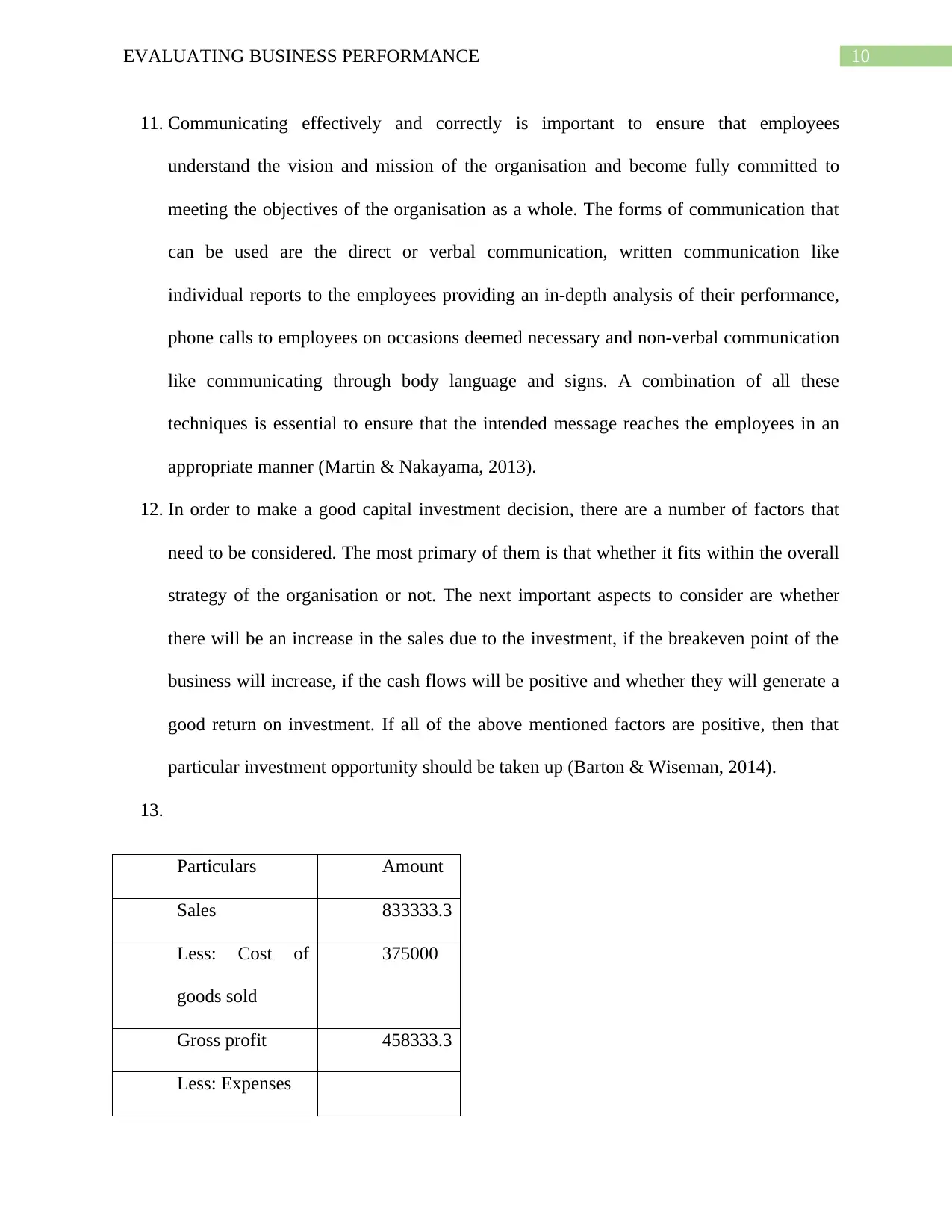
10EVALUATING BUSINESS PERFORMANCE
11. Communicating effectively and correctly is important to ensure that employees
understand the vision and mission of the organisation and become fully committed to
meeting the objectives of the organisation as a whole. The forms of communication that
can be used are the direct or verbal communication, written communication like
individual reports to the employees providing an in-depth analysis of their performance,
phone calls to employees on occasions deemed necessary and non-verbal communication
like communicating through body language and signs. A combination of all these
techniques is essential to ensure that the intended message reaches the employees in an
appropriate manner (Martin & Nakayama, 2013).
12. In order to make a good capital investment decision, there are a number of factors that
need to be considered. The most primary of them is that whether it fits within the overall
strategy of the organisation or not. The next important aspects to consider are whether
there will be an increase in the sales due to the investment, if the breakeven point of the
business will increase, if the cash flows will be positive and whether they will generate a
good return on investment. If all of the above mentioned factors are positive, then that
particular investment opportunity should be taken up (Barton & Wiseman, 2014).
13.
Particulars Amount
Sales 833333.3
Less: Cost of
goods sold
375000
Gross profit 458333.3
Less: Expenses
11. Communicating effectively and correctly is important to ensure that employees
understand the vision and mission of the organisation and become fully committed to
meeting the objectives of the organisation as a whole. The forms of communication that
can be used are the direct or verbal communication, written communication like
individual reports to the employees providing an in-depth analysis of their performance,
phone calls to employees on occasions deemed necessary and non-verbal communication
like communicating through body language and signs. A combination of all these
techniques is essential to ensure that the intended message reaches the employees in an
appropriate manner (Martin & Nakayama, 2013).
12. In order to make a good capital investment decision, there are a number of factors that
need to be considered. The most primary of them is that whether it fits within the overall
strategy of the organisation or not. The next important aspects to consider are whether
there will be an increase in the sales due to the investment, if the breakeven point of the
business will increase, if the cash flows will be positive and whether they will generate a
good return on investment. If all of the above mentioned factors are positive, then that
particular investment opportunity should be taken up (Barton & Wiseman, 2014).
13.
Particulars Amount
Sales 833333.3
Less: Cost of
goods sold
375000
Gross profit 458333.3
Less: Expenses
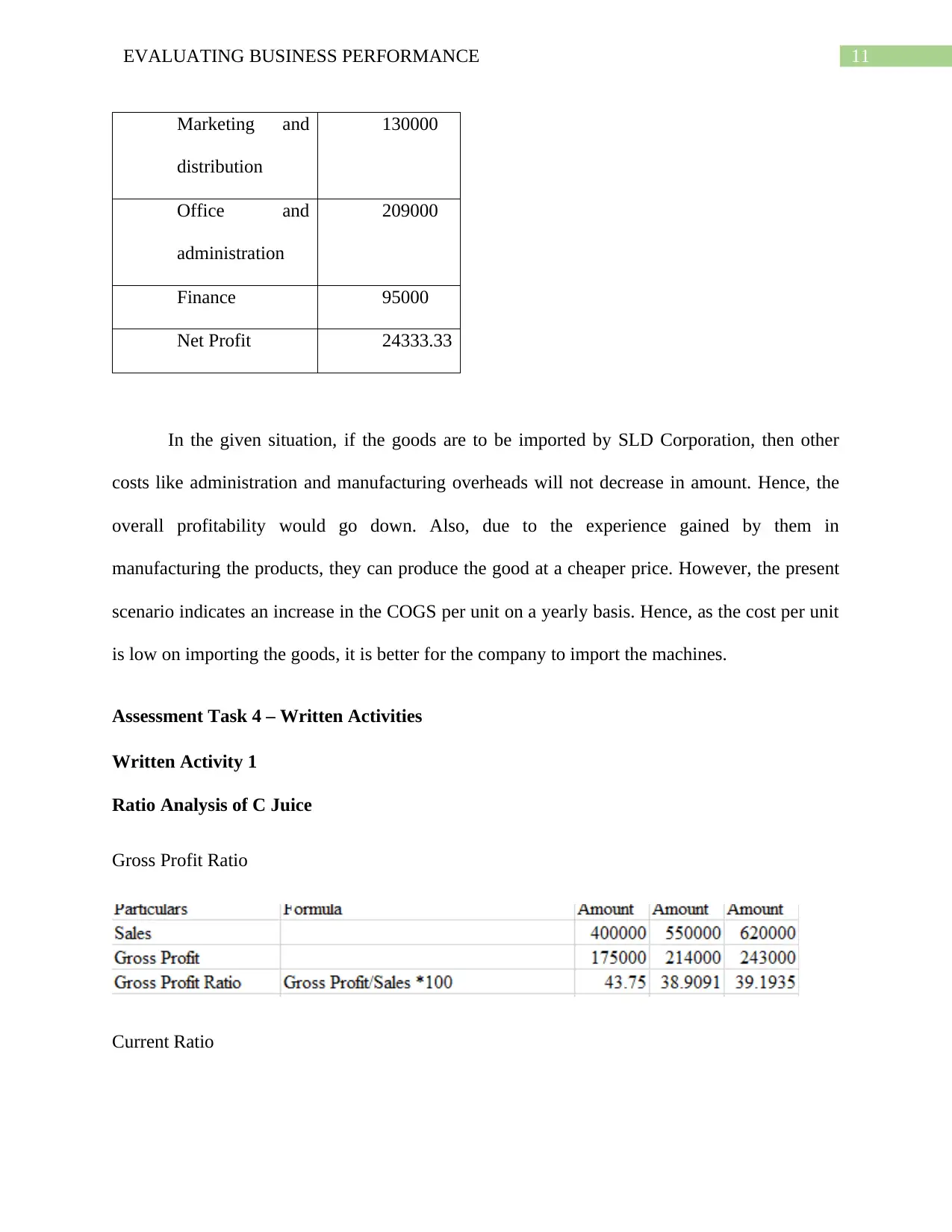
11EVALUATING BUSINESS PERFORMANCE
Marketing and
distribution
130000
Office and
administration
209000
Finance 95000
Net Profit 24333.33
In the given situation, if the goods are to be imported by SLD Corporation, then other
costs like administration and manufacturing overheads will not decrease in amount. Hence, the
overall profitability would go down. Also, due to the experience gained by them in
manufacturing the products, they can produce the good at a cheaper price. However, the present
scenario indicates an increase in the COGS per unit on a yearly basis. Hence, as the cost per unit
is low on importing the goods, it is better for the company to import the machines.
Assessment Task 4 – Written Activities
Written Activity 1
Ratio Analysis of C Juice
Gross Profit Ratio
Current Ratio
Marketing and
distribution
130000
Office and
administration
209000
Finance 95000
Net Profit 24333.33
In the given situation, if the goods are to be imported by SLD Corporation, then other
costs like administration and manufacturing overheads will not decrease in amount. Hence, the
overall profitability would go down. Also, due to the experience gained by them in
manufacturing the products, they can produce the good at a cheaper price. However, the present
scenario indicates an increase in the COGS per unit on a yearly basis. Hence, as the cost per unit
is low on importing the goods, it is better for the company to import the machines.
Assessment Task 4 – Written Activities
Written Activity 1
Ratio Analysis of C Juice
Gross Profit Ratio
Current Ratio
⊘ This is a preview!⊘
Do you want full access?
Subscribe today to unlock all pages.

Trusted by 1+ million students worldwide
1 out of 24
Related Documents
Your All-in-One AI-Powered Toolkit for Academic Success.
+13062052269
info@desklib.com
Available 24*7 on WhatsApp / Email
![[object Object]](/_next/static/media/star-bottom.7253800d.svg)
Unlock your academic potential
Copyright © 2020–2025 A2Z Services. All Rights Reserved. Developed and managed by ZUCOL.




